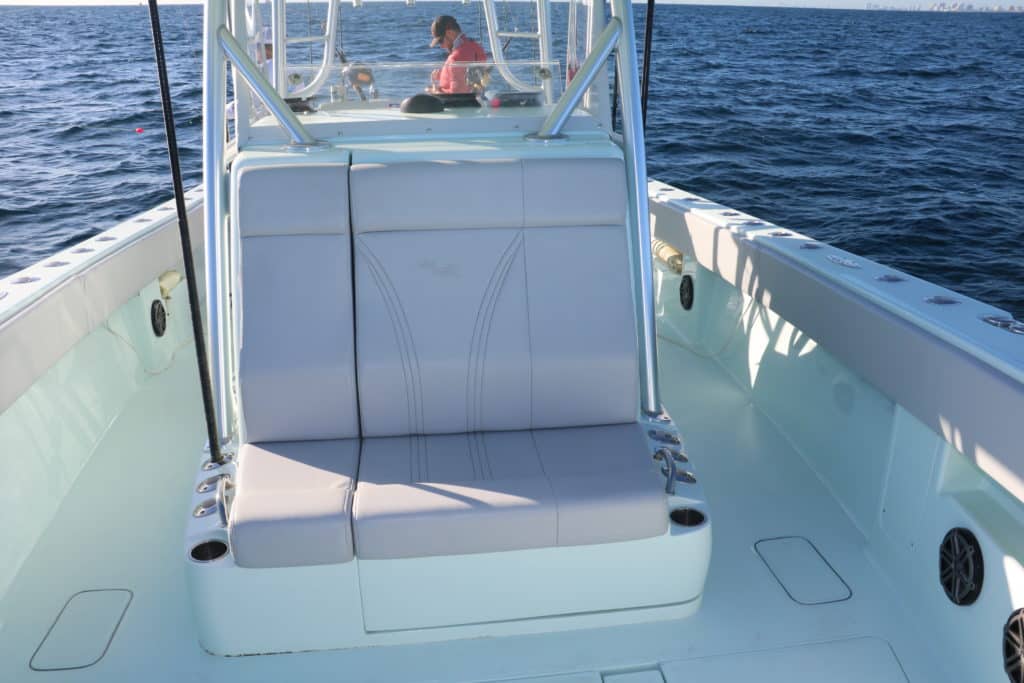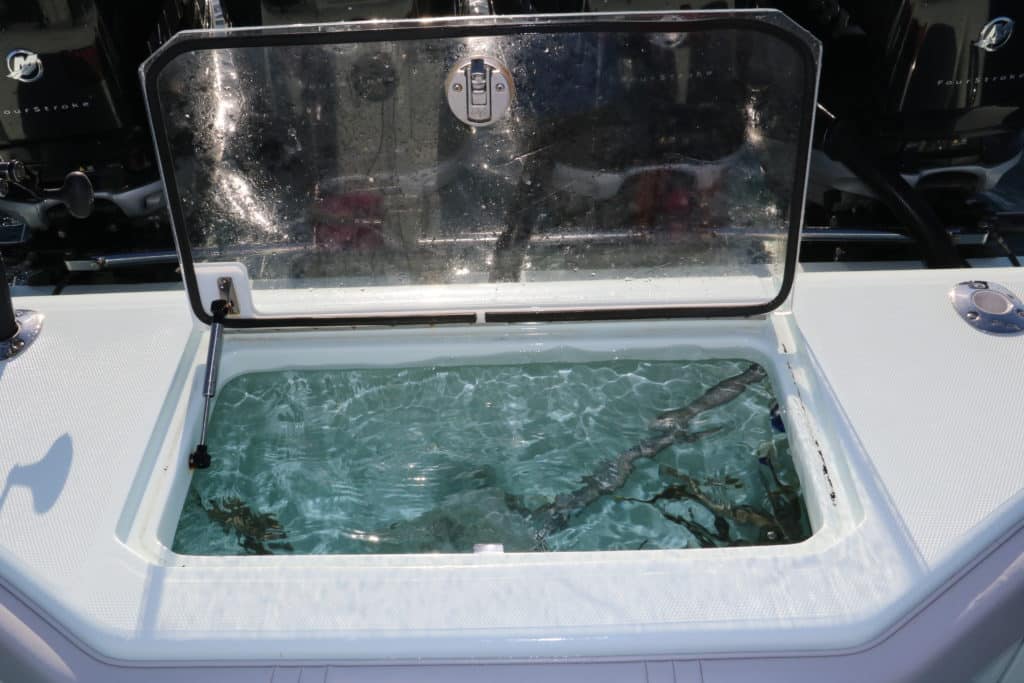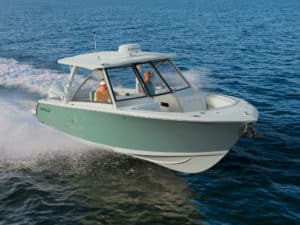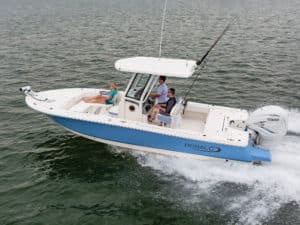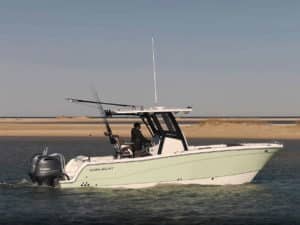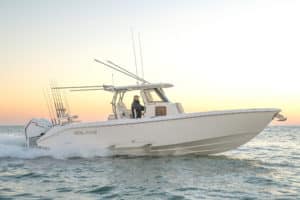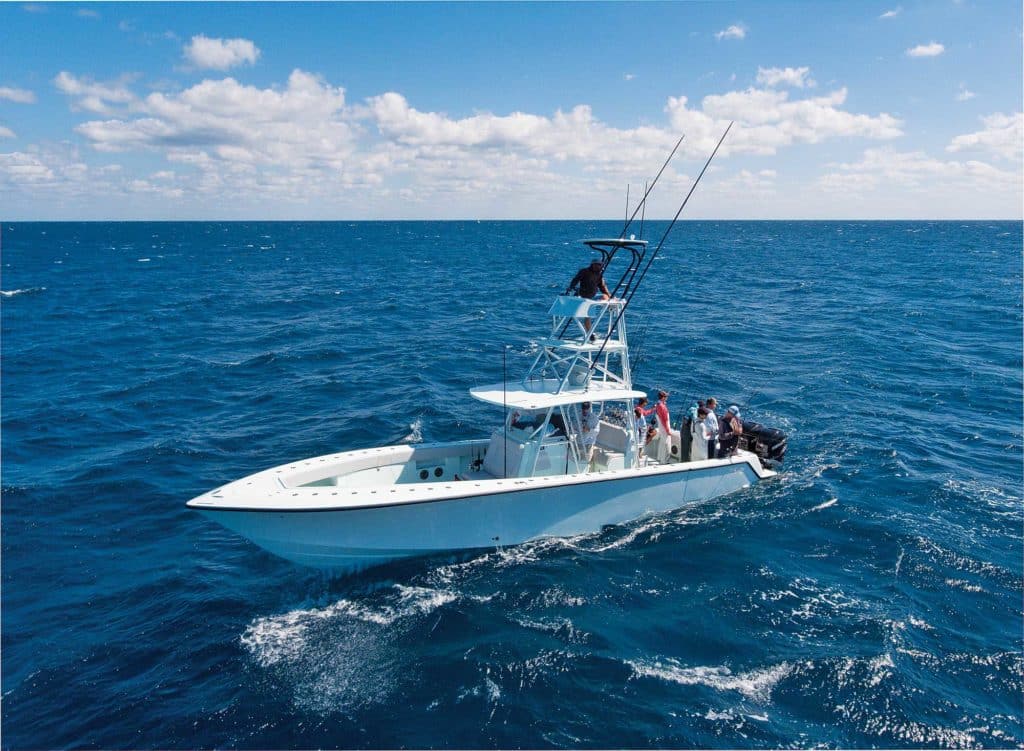
The interiors of big, new center console boats increasingly sport cushy amenities such as loungers, dining tables and posh center cabins. These add curb appeal for families but obviously don’t contribute to fishing success. In my Fish Trial of the SeaVee 390Z this past fall, I found few such elements. Save for the supportive helm seats, a perch in front of the console and a pair of beefy fold-out benches bracketing the bow, this boat was custom built for a singular mission: serious saltwater fishing.
Greeting me at the dock in Lighthouse Point, Florida, were SeaVee fishing pro Capt. Art Sapp and David Collier Jr., a member of the Sailsmen Fishing Team that competes aboard Advanced Roofing on the South Florida tournament circuit.
“You ready to catch some fish?” Sapp asked as he transferred wriggling goggle-eyes from a pair of holding pens to the pressurized 65-gallon central-transom livewell.
“Yes sir,” I answered. “It looks like we have the right boat to get it done.” While the 390Z isn’t brand new, this would be my first time fishing on it.
While we utilized only one well, we also could have filled the boat’s optional 140-gallon well under the aft deck or the 80-gallon well under the foredeck, all fed by a sea chest with six pumps.
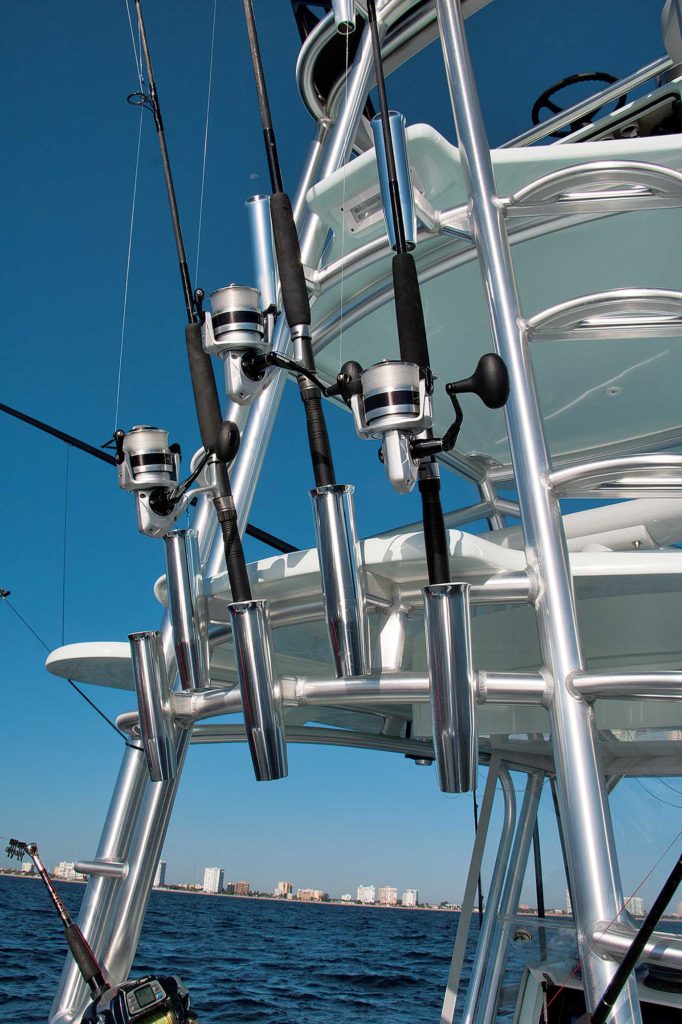
Let’s Dance
As Sapp pulled the big center console away from the dock, I marveled at the amount of deck space in the aft cockpit. “It’s like a dance floor back here,” I said to Collier. Surrounded by padded coaming bolsters, this interior gives crew members plenty of room to do‑si‑do while manning lines.
Thanks to 18 stereo speakers and four subwoofers positioned throughout the interior, the Fusion sound system provides plenty of dance music. (Even serious tournament anglers like their tunes.)
As we cleared Hillsboro Inlet, Sapp advanced the throttles, and the quad 350s vaulted the 390Z to plane in about five seconds.
The Z is SeaVee’s designation for its stepped hulls, introduced about four years ago after a lengthy process of proprietary computer design, fluid-dynamics modeling and on-water evaluations. The result is a hull that creates remarkable lift with very little bow rise as it accelerates. Two steps usher a cushion of aerated water under the hull to boost efficiency.
Our speed rose to about 45 mph as Sapp turned hard to the south at the outer marker. The 390Z responded with comforting predictability.
The down-sea run in 2-foot seas proved smooth, owing to the superbly engineered running surface. A polycarbonate enclosure wrapping around the top of the console shields the helm from wind blast. There was a solid, quiet feel as we traversed the waves, the result of the robust construction common to all SeaVee models.
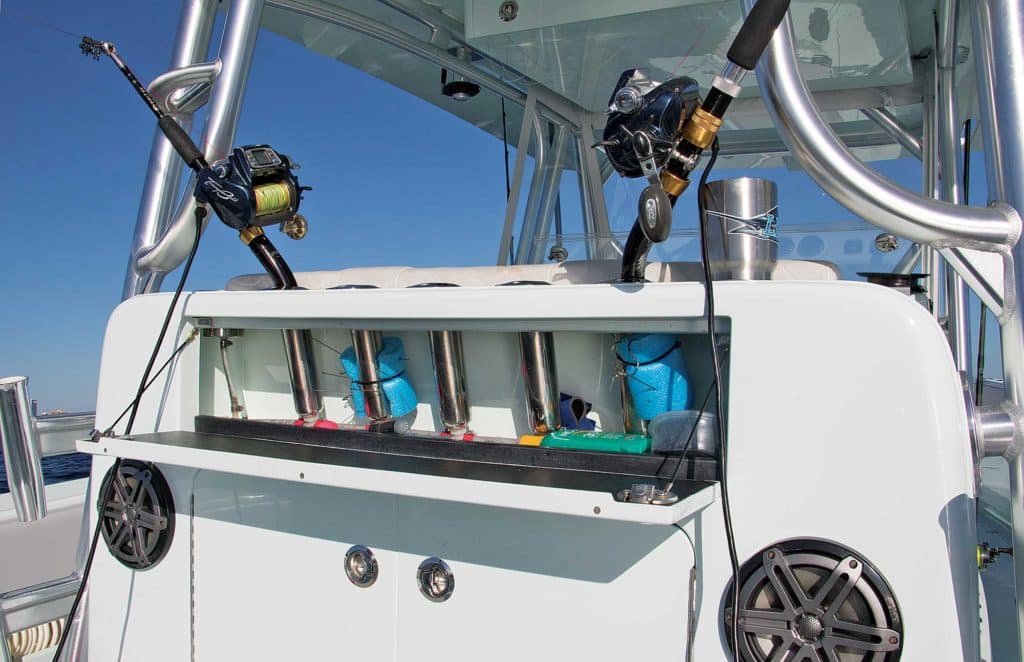
Lines In
Sapp pulled the throttles back a couple of miles below the inlet along a distinct edge of blue water. The sonar on one of the two Simrad NSS16 evo2 displays at the helm read bottom at 110 feet. A 10 to 15 mph north breeze was nearly perfect to kite-fish for sails and mahimahi.
Collier extracted the kites from a cleverly designed compartment above the helm where you might normally find an overhead electronics box. He placed a pair of electric reels in rod holders abaft the helm seating to fly the kites, then began bridling and sending out goggle-eyes.
A rigging center within the seating module offers a large cabinet to secure tackle boxes. A compartment above features a foldout table that’s perfect for keeping small tackle items handy while you’re rigging lines.
The craftsmanship and beefy construction of the anodized-aluminum tuna tower and second station (which featured a networked Simrad NSS12 evo2 display) impressed me. In a special touch, the bottom rungs of the tower’s ladders also serve as brackets for five‑gallon buckets.
Rod holders on each stern quarter allowed Collier to place the rods where he could easily access them without the need for tridents. There are eight rod holders total across the transom, with 25 punctuating each gunwale.
As we waited for a bite, I poked around and found a fish locker in the bow so massive that I could sleep inside, though I might shiver a bit, because it was equipped with a chiller plate that minimizes the need for ice. The cover consists of two smaller hatches, making it easy to slide in a 20-pound mahimahi without lifting the entire hatch. This 390Z also features an outward-opening door on the port side of the aft cockpit in case you want to haul aboard a big tuna or swordfish. Advance Roofing features SeaVee’s front-opening console. It slides open to port at the press of a button. Inside is access to immaculate helm rigging. The console proved a convenient dry stowage area for my camera gear and jacket. On the outside, eight rod holders lined each side of the console, with slots in the hardtop for the rods tips.
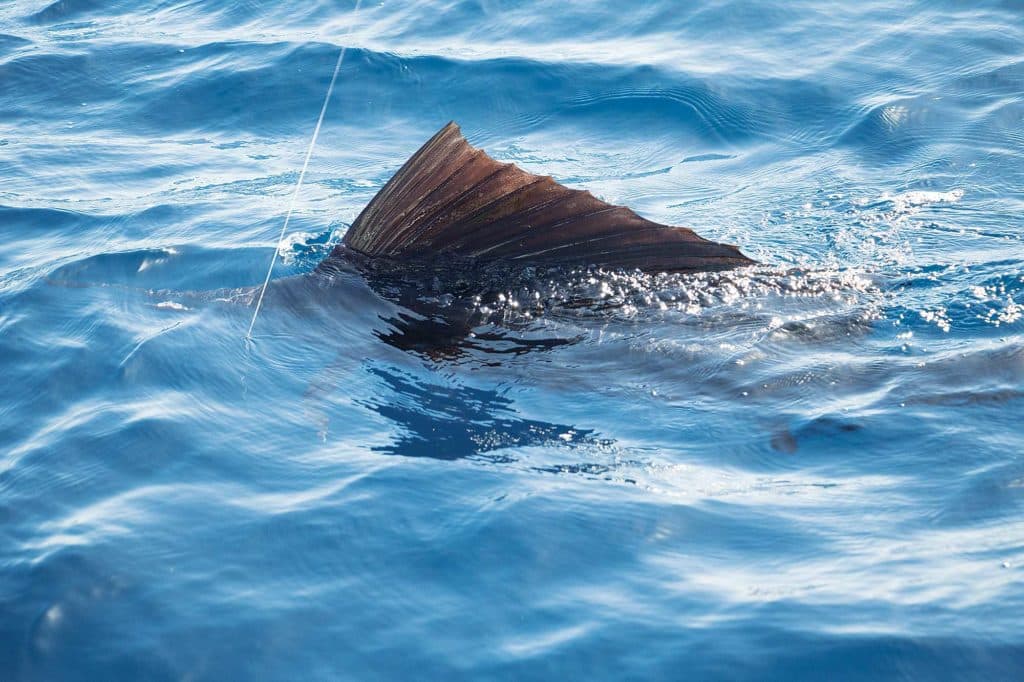
Sail Attack
My inspection was cut short when Sapp spied a sailfish attacking the bait on the left-middle line. I raced astern along level deck and wide walkways aside the console. Sapp handed me the rod. Almost instantly line began peeling off the reel, so I pushed the drag lever forward and began winding. The line grew tight, but the circle hook failed to find a home, and the sail spit the bait. An inspection of the crushed goggle-eye revealed that the hook had turned, preventing it from doing its job.
After 30 minutes with no other bites, Sapp decided to move about 2½ miles to the north. The captain stopped the boat in 380 feet of water, and it proved to be a wise choice. Almost instantly, a sail attacked the bait on the left long line, and this one stuck. I battled the acrobatic sail up the starboard side, back down the port side and across the stern before bringing it boat-side for release.
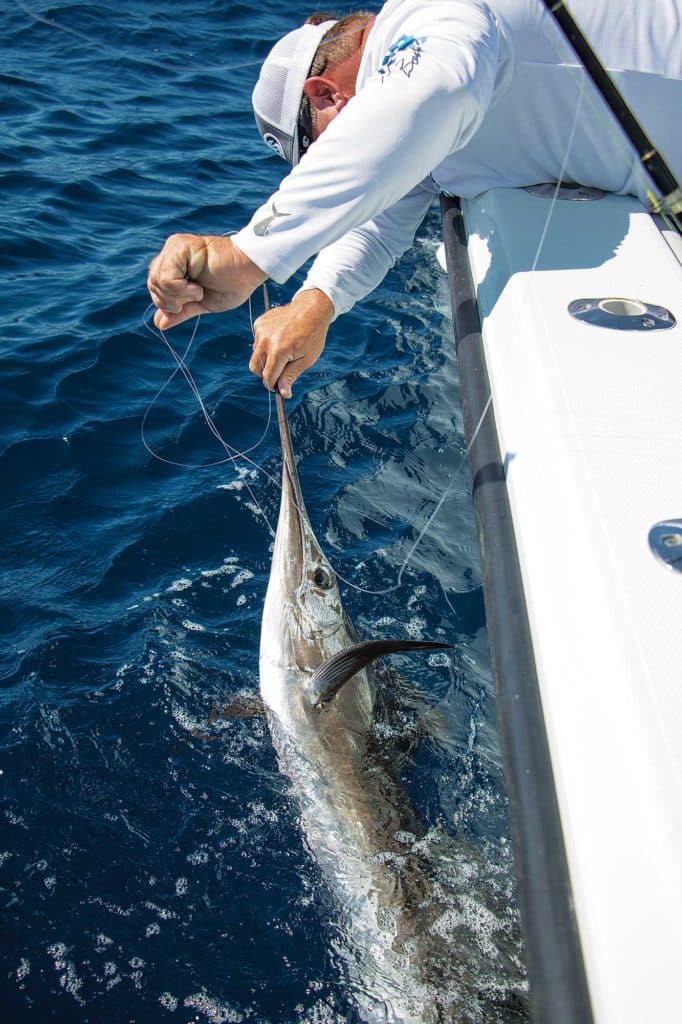
While we all wanted to stay and catch more fish, the time had come to gather performance data on the 390Z. With 120 gallons of fuel on board, the quad 350 Verados vaulted the SeaVee to plane in 5.2 seconds and reached 30 mph in 6.5 seconds. Top speed was an eye-watering 74.8 mph, with the outside engines turning 6,500 rpm and the inner outboards revving at 6,200. The engines burned 118.2 gph, resulting in 0.6 mpg.
The most economical cruising speed came at 3,500 rpm and 37.9 mph, where the four engines burned 29.2 gph for 1.3 mpg. That equates to more than 700 miles of cruising range based on the boat’s ample 563-gallon fuel capacity. Fact is, you can custom-order a SeaVee 390Z with just about whatever you want, including a wide range of luxury appointments. Yet Advanced Roofing offers few comfy compromises, rendering this SeaVee 390Z, by design, a swift and capable war wagon.
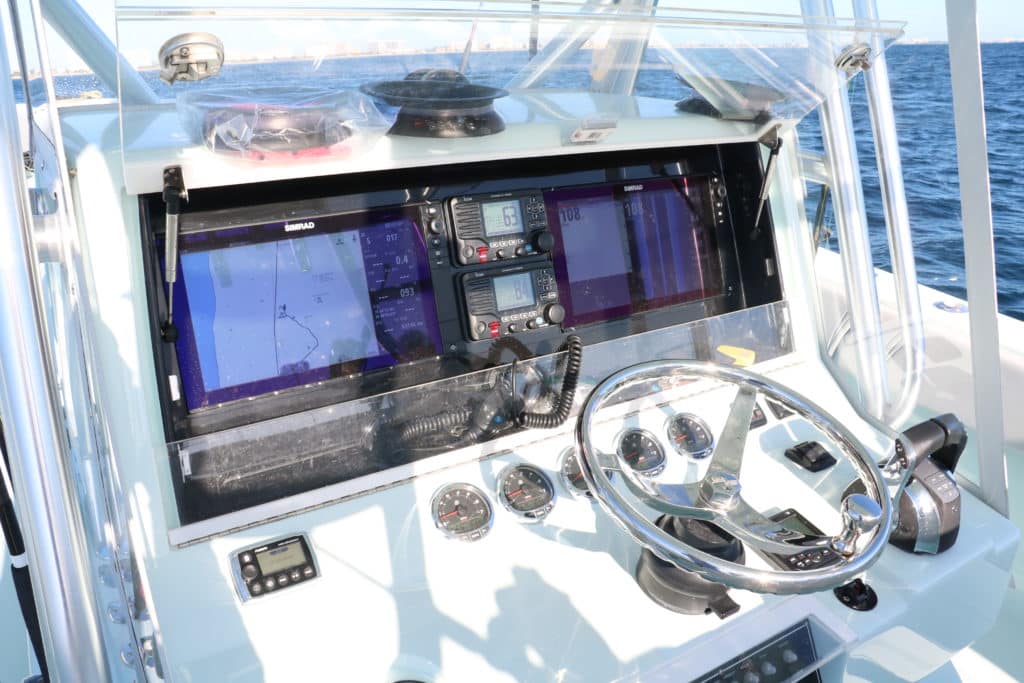
PERFORMANCE
Power: Four Mercury 350 Verado outboards Load: 120 gal. fuel, three crew Top Speed: 74.8 mph @ 6,500 rpm (outer motors), 6,200 rpm (inner motors) Time to 30 mph: 6.5 sec. Best MPG: 1.3 @ 37.9 mph (3,500 rpm)
HULL
LOA 39 ft. Beam: 11 ft. Deadrise: 22.5 deg. Dry Weight: 9,670 lb. (w/o engines) Draft: 2 ft. 2 in. Fuel: 563 gal. Max Power: 1,600 hp
MSRP: $355,500 (w/ quad Mercury 350 Verados)
SeaVee Boats
Miami, Florida
305-759-6419
